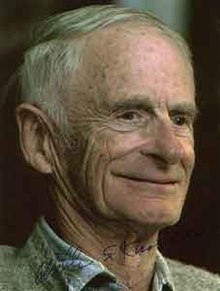William S. Knowles
| William Standish Knowles | |
|---|---|
 |
|
| Born |
June 1, 1917 Taunton, Massachusetts, U.S. |
| Died | June 13, 2012 (aged 95) Chesterfield, Missouri, U.S. |
| Fields | Chemistry |
| Institutions | Thomas and Hochwalt Laboratories Monsanto Company |
| Alma mater | Harvard University (B.S.), Columbia University (Ph.D.) |
| Doctoral advisor | Robert Elderfield |
| Known for | Chiral phosphine ligands that proved effective in the enantioselective synthesis of L-DOPA |
| Notable awards | Nobel Prize in Chemistry (2001) |
William Standish Knowles (June 1, 1917 – June 13, 2012) was an American chemist. He was born in Taunton, Massachusetts. Knowles was one of the recipients of the 2001 Nobel Prize in Chemistry. He shared half the prize with Ryōji Noyori for their work in asymmetric synthesis, specifically for his work in hydrogenation reactions. The other half was awarded to K. Barry Sharpless for his work in oxidation reactions.
Knowles attended Berkshire School in Sheffield, Massachusetts. He led his class academically and upon graduation was admitted to Harvard University after passing the College Board exams. Feeling that he was too young to go to college, Knowles spent a year at Phillips Academy in Andover, Massachusetts. At the end of the year, he captured his first award in chemistry, the school's $50 Boylston Prize.
After his year in preparatory school, Knowles attended Harvard, where he majored in chemistry, focusing on organic chemistry. He received his undergraduate degree in 1939, and attended Columbia University for graduate school.
He shared half of the Nobel Prize in Chemistry in 2001 with Ryōji Noyori for "their work on chirally catalysed hydrogenation reactions". The other half of the prize was awarded to K. Barry Sharpless for the development of a range of catalytic asymmetric oxidations. Knowles developed one of the first asymmetric hydrogenation catalysts by replacing the achiral triphenylphosphine ligands in Wilkinson's catalyst with chiral phosphine ligands. This experimental catalyst was effective for enantioselective synthesis, achieving a modest 15% enantiomeric excess.
...
Wikipedia
